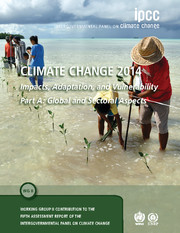 Climate Change 2014 – Impacts, Adaptation and Vulnerability: Part A: Global and Sectoral Aspects
Climate Change 2014 – Impacts, Adaptation and Vulnerability: Part A: Global and Sectoral Aspects Book contents
- Frontmatter
- Contents
- Foreword, Preface, and Dedication
- Summary for Policymakers
- Technical Summary
- Cross-Chapter Boxes
- Chapters 1-20
- Chapter 1 Point of Departure
- Chapter 2 Foundations for Decision Making
- Chapter 3 Freshwater Resources
- Chapter 4 Terrestrial and Inland Water Systems
- Chapter 5 Coastal Systems and Low-Lying Areas
- Chapter 6 Ocean Systems
- Chapter 7 Food Security and Food Production Systems
- Chapter 8 Urban Areas
- Chapter 9 Rural Areas
- Chapter 10 Key Economic Sectors and Services
- Chapter 11 Human Health: Impacts, Adaptation, and Co-Benefits
- Chapter 12 Human Security
- Chapter 13 Livelihoods and Poverty
- Chapter 14 Adaptation Needs and Options
- Chapter 15 Adaptation Planning and Implementation
- Chapter 16 Adaptation Opportunities, Constraints, and Limits
- Chapter 17 Economics of Adaptation
- Chapter 18 Detection and Attribution of Observed Impacts
- Chapter 19 Emergent Risks and Key Vulnerabilities
Chapter 8 - Urban Areas
Published online by Cambridge University Press: 05 January 2015
- Frontmatter
- Contents
- Foreword, Preface, and Dedication
- Summary for Policymakers
- Technical Summary
- Cross-Chapter Boxes
- Chapters 1-20
- Chapter 1 Point of Departure
- Chapter 2 Foundations for Decision Making
- Chapter 3 Freshwater Resources
- Chapter 4 Terrestrial and Inland Water Systems
- Chapter 5 Coastal Systems and Low-Lying Areas
- Chapter 6 Ocean Systems
- Chapter 7 Food Security and Food Production Systems
- Chapter 8 Urban Areas
- Chapter 9 Rural Areas
- Chapter 10 Key Economic Sectors and Services
- Chapter 11 Human Health: Impacts, Adaptation, and Co-Benefits
- Chapter 12 Human Security
- Chapter 13 Livelihoods and Poverty
- Chapter 14 Adaptation Needs and Options
- Chapter 15 Adaptation Planning and Implementation
- Chapter 16 Adaptation Opportunities, Constraints, and Limits
- Chapter 17 Economics of Adaptation
- Chapter 18 Detection and Attribution of Observed Impacts
- Chapter 19 Emergent Risks and Key Vulnerabilities
Summary
8.1. Introduction
8.1.1. Key Issues
Adaptation to climate change depends centrally on what is done in urban centers, which now house more than half the world's population and concentrate most of its assets and economic activities (World Bank, 2008; UN DESA Population Division, 2012). As Section 8.4 emphasizes, this will require responses by all levels of government as well as individuals and communities, the private sector, and civil society. The serious impacts of extreme weather on many urban centers each year demonstrate some of the risks and vulnerabilities to be addressed (UNISDR, 2009; IFRC, 2010). Climate change will usually add to these and other risks and vulnerabilities. Urban policies also have major implications for mitigation, especially for future levels of greenhouse gas (GHG) emissions and for delivering co-benefits, as discussed in WGIII AR5. This chapter focuses on the possibilities for governments, enterprises, and populations to adapt urban centers to the direct and indirect impacts of climate change.
The level of funding needed for sound urban adaptation could exceed the capacities of local and national governments and international agencies (Parry et al., 2009; Brugmann, 2012). Much of the investment will have to come from individuals and households, communities, and firms through their decisions to address adaptation and resilience (Agrawala and Fankhauser, 2008; Fankhauser and Soare, 2013). This might suggest little role for governments, especially local governments. But whether these small-scale decisions by households, communities, and firms do contribute to adaptation depends in large part on what local governments do, encourage, support, and prevent—as well as their contribution to providing required infrastructure and services. An important part of this is the provision by local governments of appropriate regulatory frameworks and the application of building standards, to ensure that the choices made by individuals, households, and firms support adaptation and prevent maladaptation. For instance, land use planning and management have important roles in ensuring sufficient land for housing that avoids dangerous sites and protects key ecological services and systems (UN-HABITAT, 2011a).
- Type
- Chapter
- Information
- Climate Change 2014 – Impacts, Adaptation and Vulnerability: Part A: Global and Sectoral AspectsWorking Group II Contribution to the IPCC Fifth Assessment Report, pp. 535 - 612Publisher: Cambridge University PressPrint publication year: 2014
- 12
- Cited by


